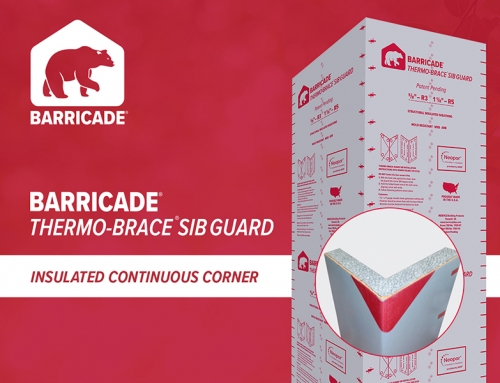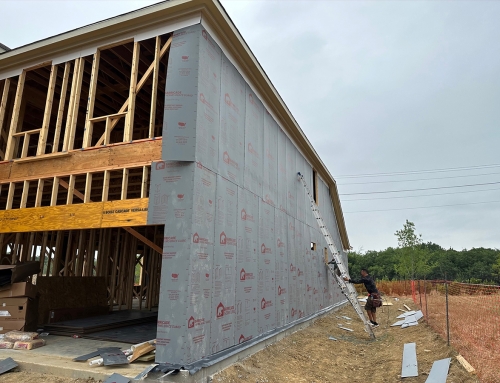The price of OSB has been on an uphill roller coaster ride for months thanks to fluctuating commodity markets.
Builders and lumber yard workers already know why more construction companies are looking for alternatives to OSB, as the price of the construction site staple has gone through the roof. Tight supplies, delivery delays, and a home renovation boom has sent prices to record-breaking levels. The fall of 2020 saw OSB selling for more than $700 per thousand square feet and rising! The pricing battle and changing builder preferences for OSB vs. plywood is good news for major suppliers like Weyerhaeuser and also for Barricade’s Thermo-Brace product line.
Key Differences Between OSB and Thermo-Brace
Thermo-Brace is manufactured in Doswell, Virginia (outside of Richmond) and is immune to the market fluctuations that determine lumber pricing. “We don’t follow the OSB wood market,” says Darcy Overby, National Sales Manager for Barricade. “They are a commodity traded product and we are not. We are an engineered kraft fiberboard product which means our raw materials are a lot more stable.”
OSB is thicker and heavier than Thermo-Brace, which creates an illusion of added strength. But when it’s used as sheathing to prevent building framing from racking, the added thickness and weight doesn’t offer any advantage. The claims are backed up by stats from the International Residential Code (see TER 1507-08) that show Thermo-Brace to be rated with higher shear values than OSB while weighing significantly less.
Secret Strength
One of the secrets to the strength is hidden under the weather-resistant barrier (WRB) surface that makes Thermo-Brace impervious to water damage on the job site. “Thermo-Brace is made from real wood fiber,” says Overby. “The material inside Thermo-Brace is virgin kraft wood fiber, which nobody else offers.” Virgin kraft wood begins its life as a tree until being ground up, mixed with adhesives and then layered over with a waterproof coating that eliminates the need for house wrap with tape at the joints. “It’s the strongest grade on the market if you’re going to use a light-weight sheathing,” says Overby. Thermo-Brace also offers a line of sheathing that features recycled wood products.
Custom Sizes
The Green, Red, and Blue lines of Thermo-Brace are available in thicknesses of .075”, .095”, and .120” respectively. There are also options available for ordering custom lengths and widths. “We do custom lengths up to 144 inches in length,” says Overby. “There is no upcharge in doing custom sizes beyond the cost of materials – we just tell the machine to change the length.” Custom sizes save the builder time and waste.
Lower Costs and No Wrap
Besides the more stable and currently much lower price, Thermo-Brace also eliminates the need to add another layer of WRB protection to exposed lumber. “Right now, we’re a third of the cost of OSB,” says Overby. “We have historically stable pricing so in the case of a mill fire or as what’s happening now with Covid, the price of our raw materials isn’t affected. We stay consistently priced. And you save on house wrap as well. If you overlap our products you don’t have to tape vertical seams.” Builders can save hundreds when you take out purchasing house wrap, scheduling installation, and labor costs.
Tightening the Building Envelope
Building a super tight building envelope has become standard operating procedure in modern construction techniques which gives Thermo-Brace another competitive edge. “We are even overlapping the panels and taping the seams even though you don’t need to do that,” says Freeman Bell of Foxworth – Galbraith Lumber Company in Plano, Texas. “The extra steps help to ensure we pass the blower door test.”
Lumber Yard Love
In addition to all the practical advantages Thermo-Brace has over the competition, lumber yards have found another reason to carry and recommend the product. “I like the fact that the product is a different color than the competitors,” says Bell “It sets us apart from the competition.”
Moving things around in the lumber yard is also simplified by laying in a supply of Thermo-Brace. “It’s not rigid and it’s lighter, says Overby. “One guy can pick up a couple of pieces at one time and it’s easier to handle on the job site.” At 315 sheets/pallet, lumber yards can also save up to 2/3 of their storage space compared to OSB.
It’s Guaranteed
Once the product gets out on the jobsite production time picks up speed thanks to boards that can be handled by one man and cut with a utility knife. Nail patterns are printed right on the sheets which flattens the installation learning curve. Naturally, the product carries a full 10-year system warranty if it’s being used with Barricade flashing and tape. It also comes standard with a 4-year panel warranty to guard against manufacturer’s defects – something the competitors don’t offer.
Closing Thoughts
A product that is vital to the construction trade that is also subject to the whims of the commodities market makes it hard for builders to stay on budget. In a world rocked by uncertainty and fenced in by razor-thin margins, it makes sense to have a sheathing in your corner that offers price stability.
Barricade’s Thermo-Brace is strong enough to walk on and can be butted, overlapped, and used as a draft stop. It doesn’t swell or soak up water like a sponge. Scrap is less of an issue on the job site as there is less leftover and what waste there is weighs less. Foil facings are available for added energy performance and the product has a greater resistance to mold (WRB on both sides) than the competition.
Standard Thermo-Brace has a higher structural shear value than other wall sheathings and is dimensionally stable. All grades provide racking resistance, and it can be used as an alternative corner bracing method, with structural ratings equivalent or better than OSB. When you add up all the benefits it’s easy to see why it’s a good time to sell out of the OSB business.
To get a quote on how much you can save by using Thermo-Brace or to explore stocking options, learn more.







